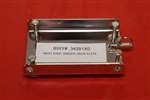I recently have been lured back into sailing after a long absence. I've picked up a "bargain" Mac 26S, and have one concern. The prior owner stated that he had bent the original mast and replaced it with a heavy duty one that was more difficult for him to raise.
I haven't had the boat in the water yet, but I'm concerned that the heavier mast might be iffy on a water ballast boat known to be somewhat tippy.
I suspect that when the M26S replaced the M25, that the stock M25 masts may have been used on the new M26S model.
I have compared my 26S replacement mast with that on a 25. Both are 28' feet long and all attachment points are the same. The replacement is visibly heavier, with a 3" X 4 1/2" oval profile instead of the smaller M25 3" X 4" teardrop profile. Using a bathroom scale, it looks like the replacement is about 17 pounds heavier at around 70 pounds. It looked like it would weigh more.
I am open to any input. If the 26S mast was originally the same as the 25, do you think the extra 17 (maybe 20) pounds will have a significant effect on the boat? If needed, I might be able to swap masts, since the heavier mast would have far less impact on the heavily ballasted 25. Any thoughts? Thanks.
I haven't had the boat in the water yet, but I'm concerned that the heavier mast might be iffy on a water ballast boat known to be somewhat tippy.
I suspect that when the M26S replaced the M25, that the stock M25 masts may have been used on the new M26S model.
I have compared my 26S replacement mast with that on a 25. Both are 28' feet long and all attachment points are the same. The replacement is visibly heavier, with a 3" X 4 1/2" oval profile instead of the smaller M25 3" X 4" teardrop profile. Using a bathroom scale, it looks like the replacement is about 17 pounds heavier at around 70 pounds. It looked like it would weigh more.
I am open to any input. If the 26S mast was originally the same as the 25, do you think the extra 17 (maybe 20) pounds will have a significant effect on the boat? If needed, I might be able to swap masts, since the heavier mast would have far less impact on the heavily ballasted 25. Any thoughts? Thanks.


